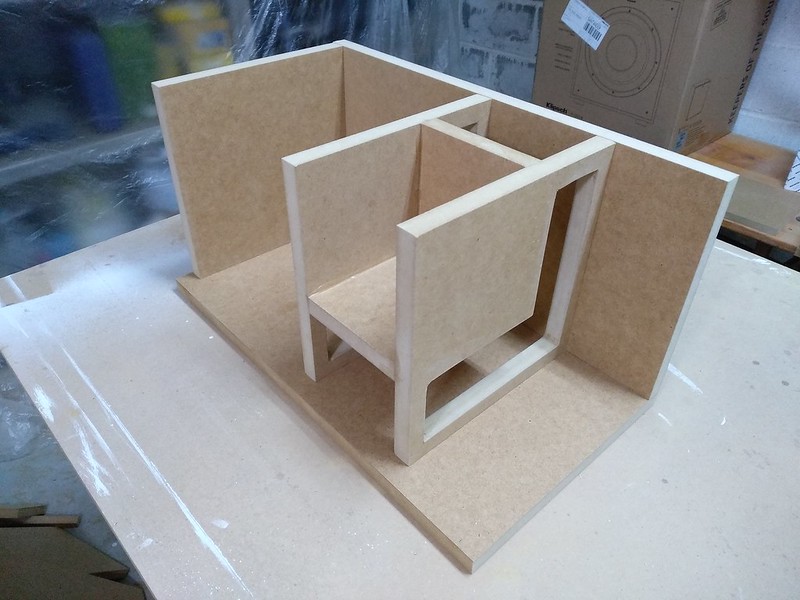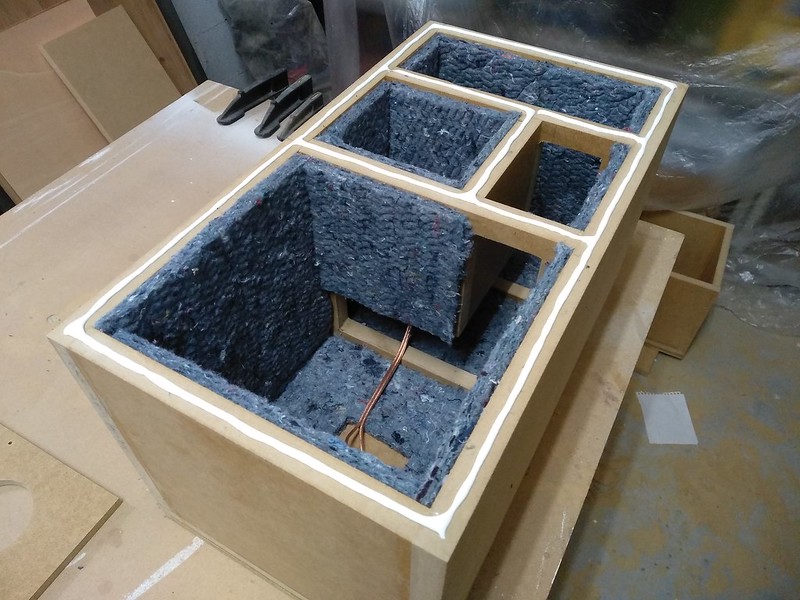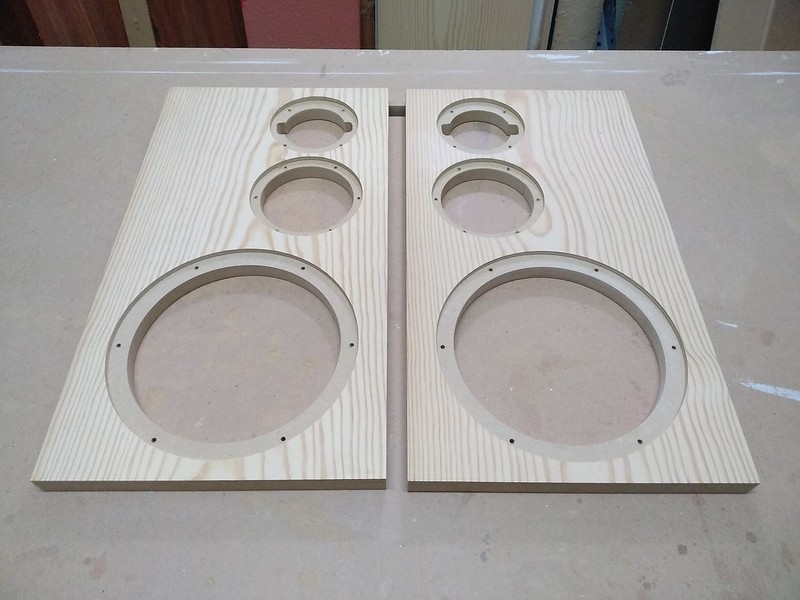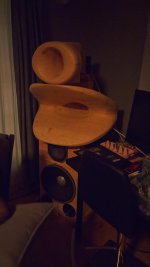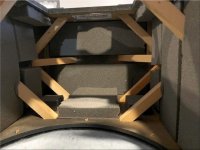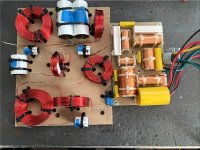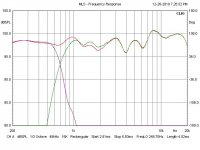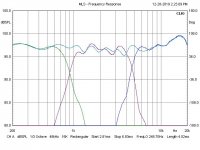Last edited:
I use 2-by-4 and 2-by-8 for my horns. It becomes very dead because of its thick walls, but has a nice tone. Similar metal horns have a harder sound. Main advantage is that you can shape it into whatever you want. The drawbacks are weight, and the time it takes to carve it out and to grind the finish. If the wood has not been dried for a year it can crack, if it has not done so already while drying. It is easy to fill the cracks with wood filler (super glue mixed with wood dust) and looks nice.
For the midwoofer cabinet I used MDF on the sides, top, bottom, and back, with some supports inside, but the front is also in pine, to keep some of the looks and tone. Everything is gently painted with Flügger Natural Wood three times with fine sandpaper in between.
It depends what you are building I guess. For a 15" JBL I am not expecting much difference in sound from using MDF or Plywood, it will sound like garbage no matter what I use. At least MDF is easy to saw out perfect pieces and glue them together, although don't underestimate the amount of clamps you need to glue it tightly.
For the midwoofer cabinet I used MDF on the sides, top, bottom, and back, with some supports inside, but the front is also in pine, to keep some of the looks and tone. Everything is gently painted with Flügger Natural Wood three times with fine sandpaper in between.
It depends what you are building I guess. For a 15" JBL I am not expecting much difference in sound from using MDF or Plywood, it will sound like garbage no matter what I use. At least MDF is easy to saw out perfect pieces and glue them together, although don't underestimate the amount of clamps you need to glue it tightly.
Attachments
Last edited:
Re: Klipsch Forte III Upgrade with Pictures!
Klipsch Forte III Upgrade with Pictures!
Pictures optimized and clarified.


* Stock Speaker Impressions
* Short Summary of Changes Made
* Upgraded Speaker Impressions
Klipsch Forte III Upgrade with Pictures!
Pictures optimized and clarified.
Cutting the braces. We did it differently than I thought we would. My idea was just to get some oak dowels and glue them lenghthwise and crosswise, flat against each interior panel. But Danny [Richie] explained that while it would make the cabinet stiffer, it would also eat up airspace. A better way for our purposes is to cut small diagonal braces and make triangle braces at key locations.
I also would have put the braces closer to the middle but Danny showed me that putting them at the 1/3rd point instead of the 1/2 point actually does a better job reducing resonance and increasing cabinet stiffness.
* Stock Speaker Impressions
* Short Summary of Changes Made
* Upgraded Speaker Impressions
OK, so that’s it for impressions. Was it worth it? Hell yeah. It didn’t fundamentally change the speaker, but it took what the Forte III was already good at and made it much better. It didn’t lose any of that “Klipsch Magic”, in fact it seriously increased the Klipsch Magic.
Attachments
Last edited:
Interesting.
Re: My X-Statik Build by Peter J
Re: My X-Statik Build by Peter J
High density MDF, like Medex and Ranger are superior to any Big Box stuff I've seen. Higher density gives slightly better panel damping in theory but also workability is enhanced. Crisper edges and dados, better screw holding capability, easier to finish, etc. I find exactly one place that I prefer standard MDF and that's the spoil board on router because I pull vacuum through it. Look at real lumber yards, if you have any near you. Cabinet shops use it and some wholesale suppliers will sell to public. Contact manufacturer and find out who distributes in your area and give 'em a call. Also if we know where you are perhaps a resource could be suggested.
I don't think there's any place you don't want NoRez except holding it back an inch or so from backs of drivers. Foam layer can be removed in areas where it's in the way, like under crossover. On the other hand, good panel damping can be accomplished without 100% coverage. The damping layer and not the foam is doing most of the damping work and the performance difference between 100% coverage and, say, 70% would be almost insignificant.
Last edited:
To complement the Klipsch Forte III comment, on axis measurements. Before and after:
Klipsch Forte III Upgrade with Pictures!
Klipsch Forte III Upgrade with Pictures!
Attachments
Last edited:
Both plywood and MDF have their pros and cons.
I like using MDF personally because it machines better and its easy enough to skin with what ever veener I might want to use. It works well for painted finishes too. The down side is finding a quality supplier.
The MDF here in the states is not as good as it was say 15 to 20 years ago before they started moving away from glues with formaldehyde in them. This does make finishing with paint a bit tricky but if you know what you are doing you can achieve piano gloss finishes that are otherwise nearly impossible to do with plywood.
MDF is usually quite a bit cheaper then top grade ply wood and can be a major factor in deciding what to use. A sheet of marine grade BB here in the states can run you close to $200.00 where as a sheet of MDF is about $30.00. If you want a wood grain finish you can buy a vainer and skin the box and it will still be cheaper then buying the same finished plywood. This is especially true when you want some of the more exotic woods or even domestic hardwoods like furniture grade 3/4" oak plywood that will run you over $120.00 a sheet. It's cheaper at the big box stores but you get what you pay for.
As far as toxicity goes, all wood dust especially the fine stuff is bad to breath in. MDF can be bad for you because the dust is going to be fine and there are the polymers used to hold it all together. Sooooo..use a dust mask. If you really want to make sure you don't breath in anything use a respirator. Problem solved.
If damping the cabinet is a concern one thing you can do is brace it in such a way that you cradle the driver's motor (magnet) with a brace that is attached to the side walls of the cabinet. This takes advantage of the weight of the driver to damp the cabinets resonances. Of course you can sandwich constrained layers of different materials if you want but that's just simply not necessary in most cases. It's one thing if you are building speakers that are housing a pair of large woofers that you plan on driving hard but a small pair of book shelf speakers it's not even necessary. I mean you can if you like but really?
If you are building a large floor standing pair of speakers one solution I have found that works to kill the cabinet is to line the inside with acoustic ceiling tiles. Cut them to fit and glue them in with PVA then rock wool and the cabs will be dead like dirt.
This is my two cents worth. I am a professional carpenter of 35 years if that means anything.
I like using MDF personally because it machines better and its easy enough to skin with what ever veener I might want to use. It works well for painted finishes too. The down side is finding a quality supplier.
The MDF here in the states is not as good as it was say 15 to 20 years ago before they started moving away from glues with formaldehyde in them. This does make finishing with paint a bit tricky but if you know what you are doing you can achieve piano gloss finishes that are otherwise nearly impossible to do with plywood.
MDF is usually quite a bit cheaper then top grade ply wood and can be a major factor in deciding what to use. A sheet of marine grade BB here in the states can run you close to $200.00 where as a sheet of MDF is about $30.00. If you want a wood grain finish you can buy a vainer and skin the box and it will still be cheaper then buying the same finished plywood. This is especially true when you want some of the more exotic woods or even domestic hardwoods like furniture grade 3/4" oak plywood that will run you over $120.00 a sheet. It's cheaper at the big box stores but you get what you pay for.
As far as toxicity goes, all wood dust especially the fine stuff is bad to breath in. MDF can be bad for you because the dust is going to be fine and there are the polymers used to hold it all together. Sooooo..use a dust mask. If you really want to make sure you don't breath in anything use a respirator. Problem solved.
If damping the cabinet is a concern one thing you can do is brace it in such a way that you cradle the driver's motor (magnet) with a brace that is attached to the side walls of the cabinet. This takes advantage of the weight of the driver to damp the cabinets resonances. Of course you can sandwich constrained layers of different materials if you want but that's just simply not necessary in most cases. It's one thing if you are building speakers that are housing a pair of large woofers that you plan on driving hard but a small pair of book shelf speakers it's not even necessary. I mean you can if you like but really?
If you are building a large floor standing pair of speakers one solution I have found that works to kill the cabinet is to line the inside with acoustic ceiling tiles. Cut them to fit and glue them in with PVA then rock wool and the cabs will be dead like dirt.
This is my two cents worth. I am a professional carpenter of 35 years if that means anything.
I have a dust collector and wear a mask using MDF or wood.
Then you are fine. I've been using the stuff professionally for many years usually without those protections and I'm cancer free.
How about the exact opposite? I've been trying to find a YT video I saw a while back (to no avail) of a thin, sound deadening material used in construction. An open ended frame was covered in it and placed over a generator, very impressive noise reduction. It was a rubbery viscous sheet, I imagine it would also have had a good damping effect on the internal sound. Just a thought and OT, but, what the hell, hasn't this question been discussed ad nauseam?
It's called Mass Loaded Vinyl and it is used as sound proofing. In order to be effective it needs to be free hanging as much as possible. It stops the transmission of sound buy turning it into heat. It works really well at attenuating frequencies above 300 hz but drops off after that. I don't think it would do much good inside a speaker box though. Dampening is more important then sound proofing in a speaker box.
...MDF personally because it machines better and its easy enough to skin with what ever veener I might want to use. It works well for painted finishes too.
All things that make MDF cheaper to use hence its appeal.
Althou i question the bit about easier to veneer.
MDF is usually quite a bit cheaper then top grade ply wood and can be a major factor in deciding what to use. A sheet of marine grade BB here in the states can run you close to $200.00 where as a sheet of MDF is about $30.00.
The differences caused by distribution. We used lots of Murphy Ply from Oregon. 1st class plywood, about double the price of MDF, less than $100 CAD (say $65 USD).
Given cost of drivers, and your labour, the cost difference is usually not that large, but sonic benefits can be large.
If you want a wood grain finish you can buy a vainer and skin the box and it will still be cheaper then buying the same finished plywood. This is especially true when you want some of the more exotic woods or even domestic hardwoods like furniture grade 3/4" oak plywood that will run you over $120.00 a sheet. It's cheaper at the big box stores but you get what you pay for.
As far as toxicity goes, all wood dust especially the fine stuff is bad to breath in. MDF can be bad for you because the dust is going to be fine and there are the polymers used to hold it all together. Sooooo..use a dust mask. If you really want to make sure you don't breath in anything use a respirator. Problem solved.
If damping the cabinet is a concern one thing you can do is brace it in such a way that you cradle the driver's motor (magnet) with a brace that is attached to the side walls of the cabinet. This takes advantage of the weight of the driver to damp the cabinets resonances.
Damping & bracing are not the same thing. I am one of the biggest cheerleaders for bracing the driver to the braces which attach to at least 3 other sides. This does not damp the cabinet, it shares the driver reactive energy more directy with more of the box so the energy available to excite any resonance drops considerably. Enuff and those potential resonances go away/
Of course you can sandwich constrained layers of different materials if you want but that's just simply not necessary in most cases. It's one thing if you are building speakers that are housing a pair of large woofers that you plan on driving hard but a small pair of book shelf speakers it's not even necessary. I mean you can if you like but really?
dave
FWIW, the last sheet of furniture grade plywood I purchased - flat sliced cheery Columbia Classic Core, with top crossband of MDF below the finish veneer - was $150 CDN at wholesale jobber price. The 8/4” solid cherry for legs and top edging was just under $6/bf, but took several hours to machine to breakout and finish to part dimensions. BTW, the Festool domino makes the Porter Cable or Lamello brand biscuit machines look like a Fisher Price toys, and makes for far superior joinery, IMHO.
But if I was still building speaker enclosures, it’d be Baltic / Euro birch - or vacuum bagged rubber-ply laminations for curved designs - with the bracing scheme Dave has already described all the way. Never did experiment with proper CLD techniques, or compliant driver mounting. The former seemed like a lot of labour for diminishing performance returns(?), and the latter just didn’t make sense for reasons already mentioned above.
But if I was still building speaker enclosures, it’d be Baltic / Euro birch - or vacuum bagged rubber-ply laminations for curved designs - with the bracing scheme Dave has already described all the way. Never did experiment with proper CLD techniques, or compliant driver mounting. The former seemed like a lot of labour for diminishing performance returns(?), and the latter just didn’t make sense for reasons already mentioned above.
I prefer plywood for its strength and lightness.
My bigger speakers were used on a mobile disco and often had to be dragged up a flight of stairs or two.
My first speaker was 4 by 12 inch in one box but wouldn't go in the car so I cut it down the middle and made two separate speakers.
My bigger speakers were used on a mobile disco and often had to be dragged up a flight of stairs or two.
My first speaker was 4 by 12 inch in one box but wouldn't go in the car so I cut it down the middle and made two separate speakers.
What reasons mentioned?Never did experiment with proper CLD techniques, or compliant driver mounting. The former seemed like a lot of labour for diminishing performance returns(?), and the latter just didn’t make sense for reasons already mentioned above.
chipboard, you mean the stuff Ikea used to make everything?
No, that would be plastic veneered hardboard with cardboard honeycomb!
This.I like using MDF personally because it machines better
I like to experiment with geometry to make my enclosures non-resonant rather than fussing over what kind of dead tree carcass it's made of or making it ridiculously thick panelled and heavy. I'd have a hard(er) time doing this in something other than MDF:

Call me dumb, but HOW do you bend MDF like that?
And the edges are so perfect too!
Looks like thin strips so should bend ok.
Bend them all together and glue them in between then clamp them.
Usually wood is bent by steaming it first.
Call me dumb, but HOW do you bend MDF like that?
And the edges are so perfect too!
In the lay up, there is 6 pieces that appear to be a total of 3/4" thick, so each layer appears to be 1/8" thick.
Once the braces are all pattern cut with a router or shaper table, they can be used for the lamination. Typically an inner skeleton is glued together with the braces and vertical spacers, then the process is glue and clamp the side panels. Ratchet straps can be used to pull the thin material against the skeleton until the glue dries.
I like to experiment with geometry...
The multiple layers of mdf gives you a plywood of sorts :^)
dave
- Home
- Loudspeakers
- Multi-Way
- Is MDF or plywood better for speaker cabinets?
